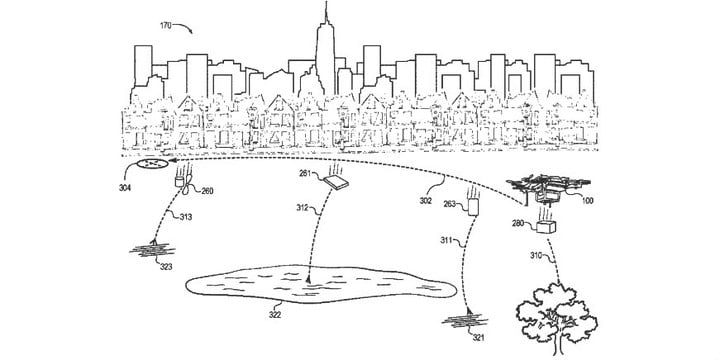Heads up, folks. It’s about to start raining drones. At least that’s the proposal made in yet another drone delivery patent from Amazon. The company’s latest patent envisages a drone that’s capable of safely self-destructing should it come into difficulty.
The online retailer has long been involved in pushing aerial deliveries into the mainstream. Testing is currently underway in Cambridge, England, but Amazon has made more headlines for its various patents than for successful delivery flights.
“Direct fragmentation for unmanned airborne vehicles”

Amazon’s latest patent makes a lot of sense. It’s inevitable that delivery drones will run into problems, whether that’s weather-related, a simple malfunction or interference from somebody on the ground. The question is then about damage limitation. How can delivery drone manufacturers prevent their UAVs from hurting people on the ground in the case of an accident?
The notion that a drone could safely disintegrate into multiple (and more importantly, lighter) pieces is interesting. The patent, titled “direct fragmentation for unmanned airborne vehicles (UAVs),” describes how a drone in trouble could dismantle itself in the sky after checking the conditions beneath it.
“The fragmentation sequence includes a release timing and a release location to fragment away (e.g., release, drop, jettison, eject, etc. away) one or more UAV components in case the flight operation of the UAV is disrupted,” the company says in the patent.
A patent for controlled destruction
Amazon is seeking to bring an element of control to the notion of self-destruction. The concept is a little more complicated than that, with a view to creating a controlled descent:
Regardless of the circumstances surrounding the disruption in flight operation, the embodiments described herein are directed to a controlled sequence for fragmenting away components of a UAV. The embodiments can be particularly helpful in case of a catastrophic failure of the UAV’s flight operation, such as one in which the UAV enters into a free fall while travelling at a certain height and speed. The embodiments can also be helpful in other cases where a disruption in flight operation is caused by partial loss of flight control.
When a loss of flight operation is detected, the UAV can enter a fragmentation sequence mode. During the fragmentation sequence, one or more parts or components of the UAV can be released. In doing so, the weight, speed, air drag coefficient, and other factors related to the UAV can be altered. At the same time, the momentum and trajectory of the UAV are also altered. According to aspects of the embodiments, the fragmentation sequence is tailored to modify or alter the manner in which the UAV descends, to control the descent in a preferred, controlled manner.
Who knows whether or not this concept will come to fruition. But it’s nice to see Amazon preparing for the worst and thinking about mitigation strategies.
Malek Murison is a freelance writer and editor with a passion for tech trends and innovation. He handles product reviews, major releases and keeps an eye on the enthusiast market for DroneLife.
Email Malek
Twitter:@malekmurison
Subscribe to DroneLife here.







[…] 2017 noticed much more patents: a digital drone security shroud, a folding wing drone design, drone supply infrastructure, the thought of “launching” packages for supply, and extra. Amazon demonstrated their drone supply program at SXSW that yr, and described a touchdown system that concerned a small “welcome mat” that owners would set out of their yard to facilitate drone supply. On the finish of the yr, DRONELIFE reported on an Amazon patent for his or her drones to “self-destruct” in case of emergency. […]